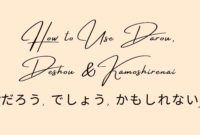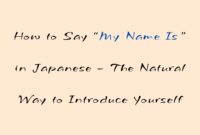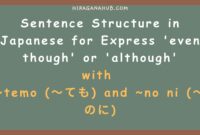Understanding Japanese Counters: ~tsu and ~nin
How to count common objects and people in Japanese with ~tsu (~つ) and ~nin (~人)?
Hello, language learners! Today, we’re going to explore two essential Japanese
counters: ~tsu (~つ) and ~nin (~人). These
counters help us quantify objects and people. Let’s simplify the explanation!
The Counter ~tsu (~つ) for Objects
The counter ~tsu is used for counting general objects. It
works for many different things, up to the number ten. After ten, you just use
regular numbers. Here’s a quick guide:
- 一つ (hitotsu) – one item
- 二つ (futatsu) – two items
- 三つ (mittsu) – three іtеmѕ
- 四つ (yottsu) – four іtеmѕ
- 五つ (itsutsu) – five іtеmѕ
- 六つ (mutsu) – six іtеmѕ
- 七つ (nanatsu) – seven іtеmѕ
- 八つ (yattsu) – eight іtеmѕ
- 九つ (kokonotsu) – nine іtеmѕ
- 十 (too) – ten items

Here are some example sentences:
-
目が二つあります – me ga futatsu arimasu:
There are two eyes. -
バナナを幾つ買いましたか? –
banana o ikutsu kaimashita ka?: How many bananas did you
buy? -
私は昨日、りんごを十個買いました –
watashi wa kinou, ringo o tokkou kaimashita: I bought ten
apples yesterday.
To count people, use ~nin (~人)
The ~nin counter is specifically for counting people. The
pronunciation changes for the numbers one and two, but after that, it’s quite
regular. Here’s the breakdown:
- 一人 (hitori) – one person
- 二人 (futari) – two people
- 三人 (sannin) – three реорlе
- 四人 (yonin) – four реорlе
- 五人 (gonin) – five реорlе
- 六人 (rokunin) – six реорlе
- 七人 (nananin) – seven реорlе
- 八人 (hachinin) – eight реорlе
- 九人 (kyuunin) – nine реорlе
- 十人 (juunin) – ten реорlе
Here are some example sentences:
-
友達が二人来ました –
tomodachi ga futari kimashita: Two friends came over. -
ミーティングには三人が出席しました –
miitingu ni wa sannin ga shusseki shimashita: Three people
attended the meeting. -
チームには十人の選手がいます –
chiimu ni wa juunin no senshu ga imasu: There are ten
players on the team.
Key Vocabulary
Here’s a quick reference for some of the important words used in the examples:
| Kanji | Hiragana | Romaji | Meaning |
|---|---|---|---|
| 一つ | ひとつ | hitotsu | one item |
| 二つ | ふたつ | futatsu | two іtеmѕ |
| 三つ | みっつ | mittsu | three іtеmѕ |
| 四つ | よっつ | yottsu | four іtеmѕ |
| 五つ | いつつ | itsutsu | five іtеmѕ |
| 六つ | むっつ | mutsu | six іtеmѕ |
| 七つ | ななつ | nanatsu | seven іtеmѕ |
| 八つ | やっつ | yattsu | eight іtеmѕ |
| 九つ | ここのつ | kokonotsu | nine іtеmѕ |
| 十 | とう | too | ten іtеmѕ |
| 一人 | ひとり | hitori | one person |
| 二人 | ふたり | futari | two people |
| 三人 | さんにん | sannin | three реорlе |
| 四人 | よにん | yonin | four реорlе |
| 五人 | ごにん | gonin | five реорlе |
| 六人 | ろくにん | rokunin | six реорlе |
| 七人 | ななにん | nananin | seven реорlе |
| 八人 | はちにん | hachinin | eight реорlе |
| 九人 | きゅうにん | kyuunin | nine реорlе |
| 十人 | じゅうにん | juunin | ten реорlе |
That’s a wrap for today! We’ve covered ~tsu for counting
items and ~nin for counting people. Both are essential
counters in daily Japanese conversations. Keep practising these counters, and
you’ll be counting like a native in no time!


